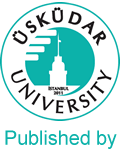ARTICLES
Original Article
Turkish Title : Comparison and Examination of the Death Anxiety of Parents with and Without Having Mental Retarded Children
Demir Gumus Zeynep,Guler Kahraman,Aktan Aner Emel,Sevimli Deniz
JNBS, 2021, 8(1), p:28-35
Aims and Objectives: The aim of this study is to have children with and without mental retardation (MR) (diagnosed with MR), it is to compare and examine parents’ death anxiety. Materials and Methods: The research is based on the screening model. The sample group of the study consists of 120 people in total, consisting of parents (n = 60) of children who are followed up in a private counseling and research center due to the presence of intellectual disability, and parents with typically developed children (n = 60) as the comparison group. Sociodemographic information of the participants, who could be included in the study on a voluntary basis, was filled in by the researcher using face to face interview method using the Sociodemographic Information Form, and their death anxiety levels were evaluated with the Multidimensional Evaluation Inventory for Death and Dying. In comparing the quantitative data of the study, the t test, which is the two independent variable tests, was used to analyze the difference between the two parametric groups. The relationship between the scales was tested with Pearson Correlation analysis. Multiple linear regression was used to see the effect of independent variables on the dependent variable. Results: As a result of the research findings, it was found that there are statistically significant differences (P < 0.05) between the scores of the compared groups. Death anxiety of parents with mentally retarded children was found to be higher than parents of typically developed children. Conclusion: This research is important in terms of providing the opportunity for cross cultural comparison and contributing to the policies to be developed on the subject..
Aims and Objectives: The aim of this study is to have children with and without mental retardation (MR) (diagnosed with MR), it is to compare and examine parents’ death anxiety. Materials and Methods: The research is based on the screening model. The sample group of the study consists of 120 people in total, consisting of parents (n = 60) of children who are followed up in a private counseling and research center due to the presence of intellectual disability, and parents with typically developed children (n = 60) as the comparison group. Sociodemographic information of the participants, who could be included in the study on a voluntary basis, was filled in by the researcher using face to face interview method using the Sociodemographic Information Form, and their death anxiety levels were evaluated with the Multidimensional Evaluation Inventory for Death and Dying. In comparing the quantitative data of the study, the t test, which is the two independent variable tests, was used to analyze the difference between the two parametric groups. The relationship between the scales was tested with Pearson Correlation analysis. Multiple linear regression was used to see the effect of independent variables on the dependent variable. Results: As a result of the research findings, it was found that there are statistically significant differences (P < 0.05) between the scores of the compared groups. Death anxiety of parents with mentally retarded children was found to be higher than parents of typically developed children. Conclusion: This research is important in terms of providing the opportunity for cross cultural comparison and contributing to the policies to be developed on the subject..
Original Article
Turkish Title : Investigation of Obsessions and Compulsions in Terms of Psychological Resilience in the Epidemic Period
Atalay Zeynep,Cebi Merve,Demir Gumus Zeynep
JNBS, 2021, 8(1), p:42-53
Aims and Objectives: In this study, obsessions and compulsions observed during the epidemic period were investigated in terms of psychological resilience. Materials and Methods: The research was conducted on a voluntary basis with 208 people (51.4% women, 48.6% men) who were exposed to the COVID 19 epidemic. Participants were given a Sociodemographic Information Form including questions about COVID 19, Vancouver Obsession–Compulsion Inventory (VOCI), and Adult Psychological Resilience Scale. Data were analyzed with Statistical Package Program for Social Science 21.0 program. Results: When the findings were examined, no difference was found between obsession–compulsion and psychological resilience in terms of total score. However, there are relationships in subdimensions. Contamination subscore of VOCI and social resources subscore of Resilience Scale for Adults were found to be higher than the others. Hoarding was higher in men, while self perception, structural style, and family cohesion were higher in women. Single participants
had higher obsession–compulsion scores, whereas married participants had higher self perception and family adjustment. It was concluded that as individuals’ age increased, their self perception and social competence increased. Relationships were also found in terms of both obsession–compulsion and psychological resilience with variables, such as the frequency of COVID 19 news and case follow up, the frequency of body screening for COVID 19 symptoms, the change in the frequency of cleaning, and the idea of getting psychological support. Conclusion: This research is significant when it comes to seeing the effect of a compulsive life event, such as an epidemic disease on obsessive and compulsive behaviors.
Aims and Objectives: In this study, obsessions and compulsions observed during the epidemic period were investigated in terms of psychological resilience. Materials and Methods: The research was conducted on a voluntary basis with 208 people (51.4% women, 48.6% men) who were exposed to the COVID 19 epidemic. Participants were given a Sociodemographic Information Form including questions about COVID 19, Vancouver Obsession–Compulsion Inventory (VOCI), and Adult Psychological Resilience Scale. Data were analyzed with Statistical Package Program for Social Science 21.0 program. Results: When the findings were examined, no difference was found between obsession–compulsion and psychological resilience in terms of total score. However, there are relationships in subdimensions. Contamination subscore of VOCI and social resources subscore of Resilience Scale for Adults were found to be higher than the others. Hoarding was higher in men, while self perception, structural style, and family cohesion were higher in women. Single participants
had higher obsession–compulsion scores, whereas married participants had higher self perception and family adjustment. It was concluded that as individuals’ age increased, their self perception and social competence increased. Relationships were also found in terms of both obsession–compulsion and psychological resilience with variables, such as the frequency of COVID 19 news and case follow up, the frequency of body screening for COVID 19 symptoms, the change in the frequency of cleaning, and the idea of getting psychological support. Conclusion: This research is significant when it comes to seeing the effect of a compulsive life event, such as an epidemic disease on obsessive and compulsive behaviors.
| ISSN (Print) | 2149-1909 |
| ISSN (Online) | 2148-4325 |
2020 Ağustos ayından itibaren yalnızca İngilizce yayın kabul edilmektedir.


